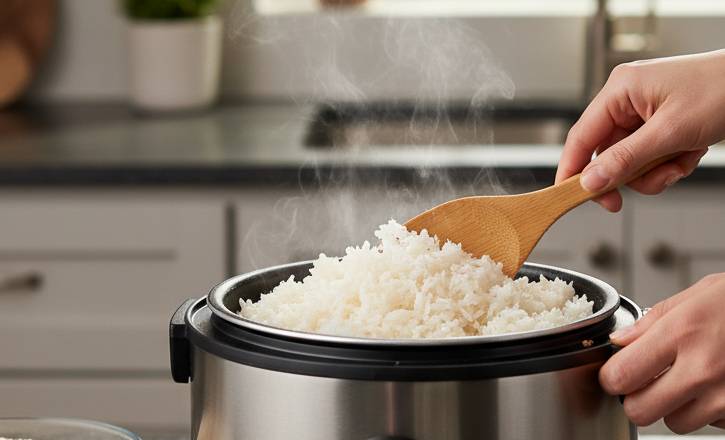
Cooking rice can seem like a simple task, but getting that ideal fluffy texture without it turning into a sticky, mushy mess can be a real challenge. Whether you’re making a side dish for your favorite curry or a base for a delicious stir-fry, mastering the basics is key. This guide will show you how to cook easy cooked rice using a simple, foolproof method that guarantees fluffy, delicious results every single time.
The Secret: The Right Ratio and a Simple Prep
The most common mistake people make is using the wrong ratio of water to rice. The golden rule is a simple one: 2 parts water to 1 part rice.
- Rinse Your Rice: This is a step many people skip, but it’s crucial for achieving fluffy, separate grains. Place your desired amount of rice in a bowl and rinse it with cold water. Swish the rice around with your hand and then pour out the cloudy water. Repeat this process 2-3 times, or until the water runs mostly clear. Rinsing removes excess starch, which is the main culprit behind mushy, sticky rice.
- Measure Accurately: Use a measuring cup to measure your rice and water. For every one cup of rice, you’ll need two cups of water. For example, if you’re cooking one cup of rice, you’ll use two cups of water.
- Use a Good Pot: A heavy-bottomed pot with a tight-fitting lid is your best friend. This will ensure even heat distribution and trap the steam needed to cook the rice perfectly.
The Cooking Process: Simple Steps, Perfect Results
Now that your rice is prepped, the cooking is a breeze.
- Bring to a Boil: Combine the rinsed rice and the measured water in your pot. Add a pinch of salt if you like. Bring the mixture to a rapid boil over medium-high heat. You’ll see bubbles forming quickly and the surface will become foamy.
- Reduce and Simmer: As soon as the water begins to boil, reduce the heat to the lowest setting possible. The water should be barely bubbling. Place the lid on the pot and do not lift it. Don’t peek! This is the most important part.
- Let It Cook: Let the rice cook for exactly 18-20 minutes on the lowest heat. The steam trapped inside the pot will gently cook the rice to perfection.
- Rest and Fluff: Once the cooking time is up, turn off the heat but leave the pot on the burner with the lid on. Let the rice rest for another 10 minutes. This allows any remaining moisture to be absorbed and the rice to firm up. Finally, remove the lid and use a fork to gently fluff the rice.
Conclusion
That’s it! By following these simple steps—rinsing the rice, using the correct water-to-rice ratio, and mastering the low-and-slow cooking method—you can say goodbye to sticky messes and hello to perfectly fluffy rice every single time. It’s a fundamental cooking skill that will elevate all your meals, and it’s easier than you ever thought.
FAQ
Q: Why is it so important to rinse the rice?
A: Rinsing rice is a key step because it removes excess starch from the surface of the grains. This starch is what causes rice to become clumpy and sticky. By rinsing it until the water runs mostly clear, you’re setting yourself up for perfectly fluffy, separated grains.
Q: Can I use the same water-to-rice ratio for all types of rice?
A: The 2:1 ratio (2 parts water to 1 part rice) is a great starting point for most long-grain white rices, like Basmati or Jasmine. However, some types of rice may require a slightly different ratio. For instance, brown rice usually needs more water and a longer cooking time (often around 2.25 to 2.5 cups of water for every 1 cup of rice), while short-grain rice might need a bit less. Always check the package instructions for the best results.
Q: Why can’t I lift the lid while the rice is cooking?
A: Lifting the lid releases the steam trapped inside the pot, which is essential for cooking the rice evenly. The low-and-slow simmering process relies on that trapped heat and steam to cook the grains all the way through. Peeking will disrupt the process and can result in unevenly cooked or undercooked rice.
Q: Do I have to let the rice rest after cooking?
A: Yes, the resting period is just as important as the cooking time. It allows the rice to absorb any remaining moisture in the pot, which helps to firm up the grains and gives you that perfect, fluffy texture. Skipping this step can lead to slightly wet or mushy rice.
Q: My rice is still mushy. What did I do wrong?
A: If your rice is mushy, it’s likely due to one of a few common mistakes:
- You didn’t rinse the rice thoroughly.
- The water-to-rice ratio was off.
- The heat was too high after you reduced it to a simmer, causing the water to evaporate too quickly.
- You didn’t let the rice rest long enough after cooking.
Try adjusting these steps on your next attempt for a better result!